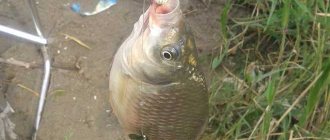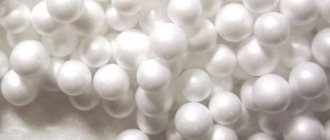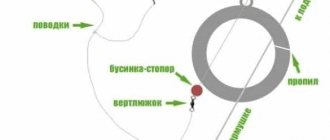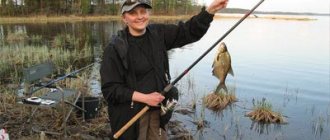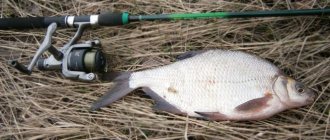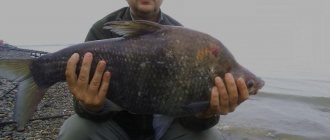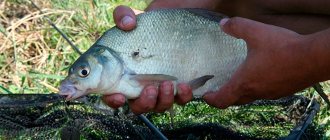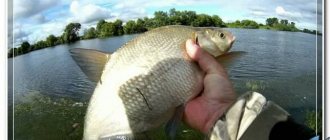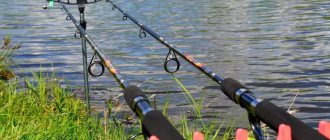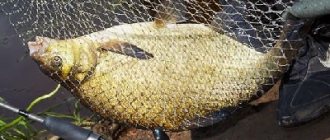- Bait
- Artificial
11992
Practice shows that polystyrene foam as bait often has an even greater effect than a dung worm or maggot. Especially in heavily silted reservoirs, where living creatures burrow into soft bottom soil, so the fish do not see them. It is difficult to say who and when first began to engage in such fishing as foam fishing. Most likely, this happened not so long ago, because just a few years ago no one knew about such fishing in our country, and if they had heard, they would have twirled their finger at their temple. However, in a surprisingly short time, fishing with foam balls has become very popular.
In its simplest form, this material has neither taste nor smell, and at the same time catches peaceful fish quite well. In addition, it is inexpensive and not in short supply; you can buy it in every fishing store.
Why fish are caught on foam plastic
There are several opinions as to why fish are caught using foam baits:
- out of curiosity for a bright and noticeable bait;
- accidentally, mistaking it for garbage;
- purposefully, perceiving the foam as food.
If you believe in practice, fishing with foam is an effective and cheap method.
Most fishermen believe that the reason for biting on foam balls is their visibility on any bottom: muddy, rocky, sandy, and clay. Out of curiosity, the fish, having discovered a white or colored ball, but bright and unfamiliar to it, decides to taste it.
Many fishermen believe that the foam is perceived by the fish as debris, preventing it from reaching food from the feeder. In this case, the larger fish swallows the foam ball, intending to pass it through the gills like any other garbage. She does not realize that there is a hook in the ball, and due to the weight of the feeder, self-hooking follows.
The average fish, which may not fit the entire foam ball in its mouth, will often catch the hook with the edge of its lip. This indicates that she does not perceive the foam as food, and she is not careful.
A very small fish tries to push away the foam ball with its head, making increasingly stronger movements. As a result, she often gets caught on the hook on her scalp.
Some fishermen are sure that fish are attracted to the foam plastic by the smell and appearance, similar to a piece of dough, corn, barley, or a pea. They treat the balls with various flavors and paint them in appropriate colors to attract fish to the bait.
Read more
How to catch chub using a cockchafer?
Fishing with foam balls: what is important to know
Fishing using polystyrene foam can be done in different conditions. But you need to realize that when fishing in stagnant water, the fish will not perceive the foam as food. In such conditions, the fish takes food mainly from the bottom. The most likely reason for biting on the foam in this case will be that the fish perceives the ball as garbage, preventing it from eating tasty food from the feeder. Therefore, when fishing with foam balls in still water, there is no need to try to give them the appearance and smell of grain. The main thing is to attract fish to the feeder.
The fish assumes that this is food that is swimming by, so it tries to swallow it
In strong or medium currents, the fish gets used to the fact that food can be found not only at the bottom, but also float past in the water column. Therefore, she may be attracted to the ball, which she will mistake for a tasty piece of food. If the ball is in an unnatural position, it may be more alarming than attracting fish. A slowly falling bait will look more familiar to her. To do this, place a foam ball over the grains of food rising from the feeder.
In addition, foam balls are used as additional bait along with the main bait (worm, maggot, grain, etc.). The role of the foam in this case will be to lift the baited hook from the bottom. This can be used effectively on a muddy bottom, as well as when catching fish that do not look for food at the bottom, but feed in the water column (siberian fish and sometimes roach).
River fishing
The method of catching bream using polystyrene foam is similar to fishing for other representatives of carp river fish: roach, sabrefish, bleak. The secrets of constructing gear for river fishing for these fish are the same with a slight difference in the length of the leashes.
For fishing in the current, you can also use a spring as a feeder, only weighted by the force of the current. If the store does not have a feeder of this type and the required weight, you can make it entirely with your own hands or weight the existing one with lead plates.
Construction of gear for the current:
- Rod. Feeder medium or heavy dough depending on the current.
- Main line. Braiding on the current is always a priority.
- Feeder. Spring with in-line mounting on a thick fishing line between reliable stoppers.
- The leash is below the feeder.
As you have already noticed, the tackle is similar to crucian carp. But catching bream on foam plastic, as well as roach, sabrefish and other river fish, involves the influence of the current.
Features of river foam equipment:
- The length of the leash in the current is about ten centimeters, in the pond - five.
- The ball-hook system in the current must have zero buoyancy, otherwise there will be no desired game, and the foam will stick out vertically, and not be in the bait train. This is achieved by using hooks made of thick wire or installing a pellet.
- The bait should contain more large fractions. For example, in the famous “salapinka” you can change the proportions of pearl barley and millet.
- To catch pelagic fish: sabrefish and bleak, unlike bottom bream and roach, leashes up to one and a half meters long are used, and the bait is made lighter, with an abundance of floating particles - rolled oats or coconut flakes.
The decision about whether to paint the balls or not, again, needs to be clarified from the inhabitants of the underwater world. It’s better to take a set of multi-colored baits with you to the river, and the roach or saberfish themselves will determine the color they like best. The same applies to the aromatization of the nozzle. It is better to use a smell like groundbait, but you can do without it.
Source: lovlyavsem.ru
Tackle for fishing with polystyrene foam
Fishing tackle for foam plastic depends on the conditions of use. In still water, you can use almost any rod that allows you to cast the equipment. It is necessary to install braided or monofilament fishing line, because the fish most often hooks itself, and high sensitivity of the gear is not required.
In such conditions, open feeders such as flat or spring are most often used. Its weight must be at least 50 g to ensure self-hooking. The fish feeder is equipped with one or two short (up to 7 cm) leashes made of dark braided fishing line so that the fish mistakes the leash for a blade of grass.
When fishing in the current, you should not use monofilament fishing lines, which have a large windage and are easily carried away. The use of braided cords dictates the requirements for the gear used. The rod must be equipped with guides made of silicon carbide or aluminum oxide. It is best to fish on a feeder.
Equipment for fishing with foam plastic is similar to the usual one.
In strong and medium currents, the best form of feeder is closed cage feeders in combination with a short leash.
Read more
Technoplankton recipes for the press for catching silver carp
For fishing with foam plastic in any conditions, only blind mounts are used so that the feeder is fixed to the fishing line motionless. Hooks should be made of thin wire, their size depends on the size of the fish.
A foam ball is placed on the hook so that the tip of the hook remains open. The size of the ball is selected to match the hook so that they have slight positive buoyancy.
The principle of operation of foam plastic as a nozzle
Fishing with foam balls is quite effective. Polystyrene foam is a good bait. It is easy to use, it does not fall off the hook, and does not get lost when casting. It is similar to the natural food that fish eat. The foam balls are shaped like pea or corn kernels. Stores sell colored foam plastic balls for fishing that imitate cereals.
In a fast current, the fish quickly captures prey, takes food at the bottom, and swallows food floating nearby. River dwellers are not distinguished by their keen eyesight; they can see objects at a distance of 1 m. Therefore, when they see a ball, they grab it as soon as possible so that other individuals do not get it.
The polystyrene foam is lightweight, so it does not sink and will remain in the water, attracting the attention of fish. The price of the material is quite small; such bait costs the fisherman almost nothing. The material holds odors well. You can soak the bait with an aromatic substance, the smell of which will last for a long time.
This material is well combined with animal bait; together with it, you can attach a larva or maggot to the hook. The balls are held perfectly on the hook. The piece of material is small in size and easily fits even in a pocket. This bait is quickly put on the hook, saving time in preparation for fishing. The material has a long service life and does not lose its shape.
Experienced fishermen use a feeder for such fishing. Without it, it is difficult to catch prey on foam pieces, even if they have an attractive smell and bright color.
When the fish swims up to the feeder, the ball rises and prevents it from swallowing the food. She pushes him away until she gets caught on the hook. The fish tries to free itself from the hook, thereby getting even more attached to it. During the current, the bait plays, causing individuals to bite.
Read: Foam fish Decorating a foam ball is quite common; pieces can be coated with aerosol paints that do not deteriorate from water. Previously, fishermen painted the bait themselves and used water-repellent aerosols; now painted balls are sold in all fishing stores.
Otherwise, the equipment for fishing with foam is standard and includes the following components:
- fishing rod from 2 to 3.7 m;
- fishing line with a diameter of 0.3 mm;
- spinning reel;
- sinker weighing up to 100 g;
- hooks for fixing on leashes - 4-5 pcs.;
- a spring 1.5 thick and no more than 10 cm long.
The installation of the feeder differs from the standard one: it is fixed firmly to the main fishing line, without using any loops. The best form of feeder is an open spring, with the weight located at the bottom. This shape will allow the food to be on top. The weight of the feeder with bait should not be more than 140 g.
Foam fishing will be more effective if you use several leads. Installation is done like this:
- You need to fix it on the sides of the feeder.
- For leashes, use a thin thread, preferably a braided line 0.1 mm thick. Leash length - 5-6 cm.
- Hooks number 4, sharp and durable.
- The pieces are placed so that the end of the hook remains open.
The balls are made of such a size that they hold the hooks vertically above the feeder. Foam baits can be used both summer and winter; in winter they need to be treated with a special spray, the smell of which will attract fish.
Flavoring and coloring of foam balls
In fishing stores there is always a selection of ready-made foam balls, painted in different colors and having different smells. It is important to choose the right size - not large, no larger than a grain of corn. But you can prepare such bait yourself by cutting the foam into appropriate pieces, giving them the desired color and aroma.
When scenting foam balls, it is important to use odors that match the smell of the bait. Flavors for fishing can be different - with the smell of vanilla, honey, hemp.
To color the balls, you can use a solution of brilliant green, fluorescent varnish, as well as natural dyes, for example, beet juice.
Bait for fishing on foam plastic
Modern bottom fishing requires the mandatory use of bait. The exception is when catching predatory fish with live bait, and even then not always. Fishing with foam plastic without bait is simply impossible. For fishing with foam balls, both ready-made dry bait mixtures and homemade bait are used.
If fishing is carried out using polystyrene foam, then the bait does not have certain features
“Store” baits can be used universally, but it is better to select them for a specific type of fish. Properly prepared homemade baits are often as effective as store-bought baits.
Basic homemade baits for fishing with foam in the current are:
- millet porridge sprinkled with flour,
- boiled peas, twisted in a meat grinder,
- half and half breadcrumbs.
For fishing in still water, in addition to those listed above, porridge made from corn grits or rolled oats is used as bait. A batter made from breadcrumbs and yogurt also works well.
It makes sense to use more complex bait compositions only with a clear understanding of the required result.
The consistency of the bait depends on the fishing conditions. It is selected in such a way that the bait is completely washed out of the feeder in 2-5 minutes, creating a cloud of bait particles around the feeder. Semolina or flour is used as a binding component, and bran or flour is used as a leavening agent.
The effectiveness of bait can be increased with the help of flavorings, but you should add them to the bait very carefully - too strong a smell will scare away the fish.
Catching crucian carp with foam balls. Video
With the onset of warm spring days at temperatures above twenty degrees, you can safely go fishing for crucian carp. In the southern regions they begin to actively catch it at the end of April. The choice of place for catching crucian carp must be approached selectively, since in different bodies of water its spawning time differs significantly.
As bait for crucian carp, it is best to choose porridge with loose powder:
- The poppy seed should be chosen fresh, with a rich aroma.
- Pearl barley porridge is cooked with millet and dry corn grits are added.
- Barley, millet and corn grits should be in a ratio of 1:2:4.
- In extreme heat, to preserve the bait, it is recommended to place it in a thermal bag or thermal bag.
Makukha should be added until the bait acquires a dark color.
Fishing Features
Polystyrene foam is put on the hooks , and the spring is tightly clogged with porridge immediately before fishing. The bait should be packed so that it does not spill out when it hits the water and is not washed out when it remains at the bottom of the reservoir for a long time.
The cast should be made into the expected habitat of the crucian carp. After the feeder sinks to the bottom, the fishing line must be slightly tensioned. In this case, you need to make sure that the feeder does not move. This is important because when the spring fell, some parts of the feed fell and settled around the fishing point. The fish begins to react to them, gradually swimming up to the spring.
Pieces of millet porridge and cake begin to float above the feeder. The crucian carp, captivated by the food it has caught, begins to grab the foam placed on the hooks.
Thanks to the open sting and sharpness of the hooks, the fish often hook themselves. When it bites, there is first a sharp jerk, and then the line sags. Prey can be pulled out of the water.
When fishing for crucian carp, you don’t need to be afraid to experiment. He may not bite because of some insignificant detail. When preparing to fish with foam balls, you can watch several videos with useful tips from experienced fishermen.
Source: ulov.guru
Fishing with Oleg Yavorovich
How to make catchy bottom tackle with your own hands? This question is often asked by novice fishermen. In this video lesson, you will see how you can make excellent bottom tackle that will catch peaceful fish in your pond. Raising funds to support the channel. WebMoney WMR - WALLET R814777772665 WMU - WALLET U842899838595 WMZ - WALLET Z237617817394 Privat Bank 5168 7551 0973 7540 Yavorovich Oleg FB Group https://www.facebook.com/groups/Yavafishing/ Production Music courtesy of Epidemic Sound" https://www. epidemicsound.com/ Catchable mastyrka
Bait https://gstream.com.ua Do-it-yourself nod (guard) for winter fishing.
Nod for summer fishing
Lures for winter fishing. https://www.youtube.com/playlist?list=PLUUqMoTprOX6Q3Snfz2si1v6MXEqEf_W8 Fishing with a bullet
Catchy bait in the fall.
Predator bait.
Catching a predator with a bullet.
Catching pike perch with a bullet.
Pike, pike perch, catfish.
Fishing on a new boat.
Big fish in the cage.
Catching large carp with a bullet.
Predator bait.
Release for wobblers, spinners and jigs.
How to do maintenance on your reel..
Catching zander.
Is the bullet a poaching tackle or......
Catching fish with a bullet.
Hunting for poachers.
Fishing. Bullet beard.
How to make a bullet bait
Fishing knot.
Catching fish with a bullet
Predator bait.
This is fishing.
Fishing. Pike, pike perch, catfish.
We were looking for pike perch, pike, catfish, but caught....|
Catching pike with a Mepps spinner
Huge pike
https://youtu.be/wJnWR0oaQU
#Fishing_with_Oleg_Yavorovich #fish #carp #pike #pike perch #fishing_2018 #with your own hands #for_fishing #spinning #huge #carp #bullet #fishing #summer jig #fishing
6 months ago
Source: bstomatolog.info
When is the best time to fish with foam?
On the current, foam plastic for fishing is used as bait with the greatest success in the spring and early summer, since it is at this time of year:
Read more
How to catch fish with a vibrotail?
This bait is in great demand among fish from early spring to early summer.
- the water has a temperature that helps the fish catch the smell of bait from afar;
- the fish eats up after winter, trying to gain strength before and after spawning, and responds well to bait.
Starting from mid-summer, fish respond less well to bait, so using polystyrene foam for fishing is not very effective.
In still water, the best results when fishing with foam come in the summer, when the fish switches from animal food to plant food.
The bite is greatly influenced by weather conditions. With the onset of spring, the warmer and sunnier it is, the better the fish bite. But in the summer, when the heat begins, it is better to catch fish with foam in cloudy weather, with light rain, as well as at dawn or before sunset.
